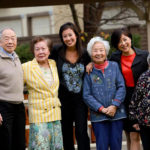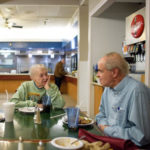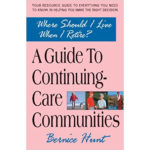 SENIOR LIVING COMMUNITIES
SENIOR LIVING COMMUNITIES
Articles
 At Colleges, What’s Old Is New: Retirees Living on Campus College is a place to escape parental oversight for many new arrivals. But a growing trend on college campuses — to place retirement homes near the dorms — may one-day prompt students to ask: “Is that grandma over there on the quad?” – NewYorkTimes.com
At Colleges, What’s Old Is New: Retirees Living on Campus College is a place to escape parental oversight for many new arrivals. But a growing trend on college campuses — to place retirement homes near the dorms — may one-day prompt students to ask: “Is that grandma over there on the quad?” – NewYorkTimes.com
 Tiny Homes: An Interdisciplinary Residential Universal Design Project The tiny home movement has been sweeping the United States and is often discussed in conversations about sustainable living, affordable housing, multigenerational living, and downsizing in retirement. – changingaging.org
Tiny Homes: An Interdisciplinary Residential Universal Design Project The tiny home movement has been sweeping the United States and is often discussed in conversations about sustainable living, affordable housing, multigenerational living, and downsizing in retirement. – changingaging.org
 Why Senior Housing Needs to Change to Appeal to Boomers Boomers are known for being a generation of influencers, rebels and change leaders. Now, they’re in a position to force a dismantling of the old models of senior housing. – nextavenue.com
Why Senior Housing Needs to Change to Appeal to Boomers Boomers are known for being a generation of influencers, rebels and change leaders. Now, they’re in a position to force a dismantling of the old models of senior housing. – nextavenue.com
 Elderly Japanese Women Live in the World’s Most Enchanting Retirement Home Jikka was initially created for two retirement-ready women in their 60s—one was a social worker and the other was a cook. – mymodernmet.com
Elderly Japanese Women Live in the World’s Most Enchanting Retirement Home Jikka was initially created for two retirement-ready women in their 60s—one was a social worker and the other was a cook. – mymodernmet.com
 How a Continuing Care Retirement Community Works How CCRC’s work is a question that often pops up when our discussions turn to where and how to live as one gets older. This article explains how this model of retirement living works and discusses their financial model. – Tech-enhancedLife.com
How a Continuing Care Retirement Community Works How CCRC’s work is a question that often pops up when our discussions turn to where and how to live as one gets older. This article explains how this model of retirement living works and discusses their financial model. – Tech-enhancedLife.com
 Where Do the Nation’s Oldest Citizens Live? Communally, in Cities The majority of the nation’s oldest citizens do not live by themselves—they live in some sort of communal setting or with family members, and in the next four decades their ranks are projected to grow substantially. Only a little more than third of centenarians, both male and female, lived alone in 2010, according to the U.S. Census Bureau, while most lived with others. – Senior Housing News
Where Do the Nation’s Oldest Citizens Live? Communally, in Cities The majority of the nation’s oldest citizens do not live by themselves—they live in some sort of communal setting or with family members, and in the next four decades their ranks are projected to grow substantially. Only a little more than third of centenarians, both male and female, lived alone in 2010, according to the U.S. Census Bureau, while most lived with others. – Senior Housing News
 Retirement in a Community. But Which One? Five years after she began her quest at age 62, Ms. Canfield moved in to just the sort of place she had been looking for: a two-bedroom, two-bathroom home in Symphony Village, an active adult community in Centreville, Md., 15 minutes from her daughter and family. “When I came here it was so different,” she said. “Everyone seemed younger and more vibrant. They were out and doing things.” – The New York Times
Retirement in a Community. But Which One? Five years after she began her quest at age 62, Ms. Canfield moved in to just the sort of place she had been looking for: a two-bedroom, two-bathroom home in Symphony Village, an active adult community in Centreville, Md., 15 minutes from her daughter and family. “When I came here it was so different,” she said. “Everyone seemed younger and more vibrant. They were out and doing things.” – The New York Times
 Justice Department Takes Down Barriers in Retirement Homes When the dispute started four years ago, residents and their children figured it would be easily resolved. The seniors liked living at Harbor’s Edge, an upscale continuing care retirement community in Norfolk, Va. They appreciated its amenities, including River Terrace, a gracious dining room with waterfront views. When a neighbor or spouse had to move from independent living to assisted living or to the nursing unit — the very transitions this kind of graduated facility is designed to accommodate — their friendships endured. – The New York Times
Justice Department Takes Down Barriers in Retirement Homes When the dispute started four years ago, residents and their children figured it would be easily resolved. The seniors liked living at Harbor’s Edge, an upscale continuing care retirement community in Norfolk, Va. They appreciated its amenities, including River Terrace, a gracious dining room with waterfront views. When a neighbor or spouse had to move from independent living to assisted living or to the nursing unit — the very transitions this kind of graduated facility is designed to accommodate — their friendships endured. – The New York Times
 Continuing Care Retirement Communities When your parent or loved one decides they’re ready to move from the family home, Continuing Care Retirement Communities (CCRCs) may be worth considering. Offering a variety of services within one community, CCRCs guarantee lifetime housing, social activities and increased levels of care as needs change. These features, however, do come with a price. Learn more about CCRCs to decide whether they’re right for your loved one. – AARP
Continuing Care Retirement Communities When your parent or loved one decides they’re ready to move from the family home, Continuing Care Retirement Communities (CCRCs) may be worth considering. Offering a variety of services within one community, CCRCs guarantee lifetime housing, social activities and increased levels of care as needs change. These features, however, do come with a price. Learn more about CCRCs to decide whether they’re right for your loved one. – AARP
 The Giant Retirement Community That Explains Where Americans Are Moving The Villages, Fla., an hour northwest of Orlando, may be the only retirement community that is also the center of its own census-designated statistical area. It also holds another distinction: In 2014, its population rose more quickly than that of any other census area in the United States, climbing 5.4 percent, compared with 0.7 percent for the nation as a whole. – New York Times
The Giant Retirement Community That Explains Where Americans Are Moving The Villages, Fla., an hour northwest of Orlando, may be the only retirement community that is also the center of its own census-designated statistical area. It also holds another distinction: In 2014, its population rose more quickly than that of any other census area in the United States, climbing 5.4 percent, compared with 0.7 percent for the nation as a whole. – New York Times
 Mean Girls in the Retirement Home The notion that a threat to seniors is their peers is somewhat new and usually played for laughs. It goes against a truism handed down from mothers to daughters for generations: This, too, shall pass. Mean girls are not girls, or mean, forever. High school doesn’t last forever, everyone grows up. But Nanna’s experience suggests otherwise. — The New York Times
Mean Girls in the Retirement Home The notion that a threat to seniors is their peers is somewhat new and usually played for laughs. It goes against a truism handed down from mothers to daughters for generations: This, too, shall pass. Mean girls are not girls, or mean, forever. High school doesn’t last forever, everyone grows up. But Nanna’s experience suggests otherwise. — The New York Times
 In Cleveland, Young and Old Keep Tempo of Life Here at Judson, young and old play nicely together, part of an intergenerational program that has led to harmonious relationships beyond the concerts. While many residences for older people are regularly serenaded by the local high school band or other area musicians, Judson Manor’s initiative has taken such interaction several steps further. – The New York Times
In Cleveland, Young and Old Keep Tempo of Life Here at Judson, young and old play nicely together, part of an intergenerational program that has led to harmonious relationships beyond the concerts. While many residences for older people are regularly serenaded by the local high school band or other area musicians, Judson Manor’s initiative has taken such interaction several steps further. – The New York Times
 The Case for Aging in Community, Not in Place Continuing Care Retirement Community (CCRC) can greatly increase independence. A CCRC provides unique opportunities for a safe, meaningful and productive life as one grows older. The idea that independence is best preserved by aging in place is a myth exposed when elders must rely on family, friends, a plethora of professional caregivers and, often, an assisted living facility or nursing home.— American Society on Aging
The Case for Aging in Community, Not in Place Continuing Care Retirement Community (CCRC) can greatly increase independence. A CCRC provides unique opportunities for a safe, meaningful and productive life as one grows older. The idea that independence is best preserved by aging in place is a myth exposed when elders must rely on family, friends, a plethora of professional caregivers and, often, an assisted living facility or nursing home.— American Society on Aging
 New Model of Continuing-Care Retirement Communities: ‘CCRCs Without Walls’ Thinking about moving to a so-called CCRC, or continuing-care retirement community? Perhaps you could stay in your home—and have the community come to you.— Wall Street Journal
New Model of Continuing-Care Retirement Communities: ‘CCRCs Without Walls’ Thinking about moving to a so-called CCRC, or continuing-care retirement community? Perhaps you could stay in your home—and have the community come to you.— Wall Street Journal
 The Everything-in-One Promise of a Continuing Care Community Is it possible to have it all in retirement? That’s what so-called continuing care retirement communities promise. These hybrids offer independent living apartments (and sometimes free-standing cottages) along with assisted-living support, home care, a nursing home and often specialized memory care, all within one complex. The idea is for a resident to “age in place” and obtain additional services as that person becomes more frail and dependent, without having to move. – The New York Times
The Everything-in-One Promise of a Continuing Care Community Is it possible to have it all in retirement? That’s what so-called continuing care retirement communities promise. These hybrids offer independent living apartments (and sometimes free-standing cottages) along with assisted-living support, home care, a nursing home and often specialized memory care, all within one complex. The idea is for a resident to “age in place” and obtain additional services as that person becomes more frail and dependent, without having to move. – The New York Times
 Risks and Rewards of Moving to a CCRC (video and article) Imagine hunting for a new home, making high-stakes health care decisions and negotiating a complex business deal—all at the same time. That’s the challenge facing seniors considering a move to a continuing-care retirement community.— Kiplinger
Risks and Rewards of Moving to a CCRC (video and article) Imagine hunting for a new home, making high-stakes health care decisions and negotiating a complex business deal—all at the same time. That’s the challenge facing seniors considering a move to a continuing-care retirement community.— Kiplinger
 Made-to-Order CCRC Units Redefine Senior Living Continuing care retirement communities (CCRCs) are more than just real estate — they’re lifestyle choices. But until recently, the physical apartments haven’t quite reflected residents’ hobbies, interests or preferences on an individual basis, some say. A new model is changing that.The “lifestyle apartment” model seeks to mirror residents’ lifestyles by basing the design and functionality of the units on residents’ daily activities.— Senior Housing News
Made-to-Order CCRC Units Redefine Senior Living Continuing care retirement communities (CCRCs) are more than just real estate — they’re lifestyle choices. But until recently, the physical apartments haven’t quite reflected residents’ hobbies, interests or preferences on an individual basis, some say. A new model is changing that.The “lifestyle apartment” model seeks to mirror residents’ lifestyles by basing the design and functionality of the units on residents’ daily activities.— Senior Housing News
 Rethinking the Traditional Retirement Community A California project is one of many efforts by developers to think more creatively about housing options for a demanding generation that has begun to reach retirement age. Instead of focusing on traditional Sun Belt retirement communities, builders are seeking to lure older people who want to remain active or continue to work. Pleasing retirement-age customers is crucial for developers. At a time when many housing markets remain stagnant, projects catering to older people rank as one of the hottest fields. – The New York Times
Rethinking the Traditional Retirement Community A California project is one of many efforts by developers to think more creatively about housing options for a demanding generation that has begun to reach retirement age. Instead of focusing on traditional Sun Belt retirement communities, builders are seeking to lure older people who want to remain active or continue to work. Pleasing retirement-age customers is crucial for developers. At a time when many housing markets remain stagnant, projects catering to older people rank as one of the hottest fields. – The New York Times
Other organizations
Books
 Continuing Care Retirement Communities by Bernice Hunt This is a complete guide to one of the most popular retirement options―Continuing Care Retirement Communities (CCRCs)―where you can enjoy life to the fullest, knowing that if you become ill, you’ll receive all the care you need. It explains what CCRCs are, how they operate, and what they offer. You’ll learn what to look for, what to steer clear of, what you have a right to expect, and how you can best make the transition when you move.
Continuing Care Retirement Communities by Bernice Hunt This is a complete guide to one of the most popular retirement options―Continuing Care Retirement Communities (CCRCs)―where you can enjoy life to the fullest, knowing that if you become ill, you’ll receive all the care you need. It explains what CCRCs are, how they operate, and what they offer. You’ll learn what to look for, what to steer clear of, what you have a right to expect, and how you can best make the transition when you move.


